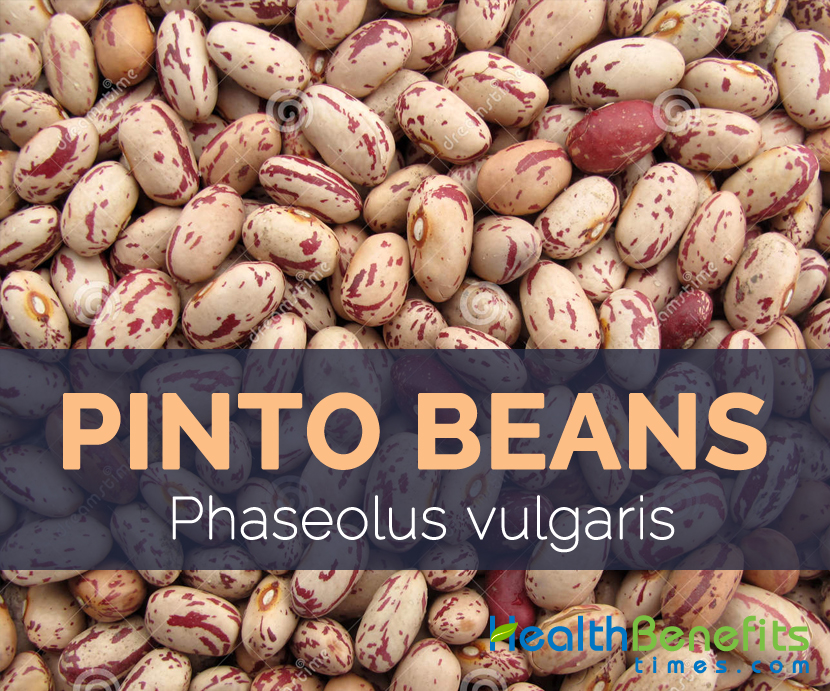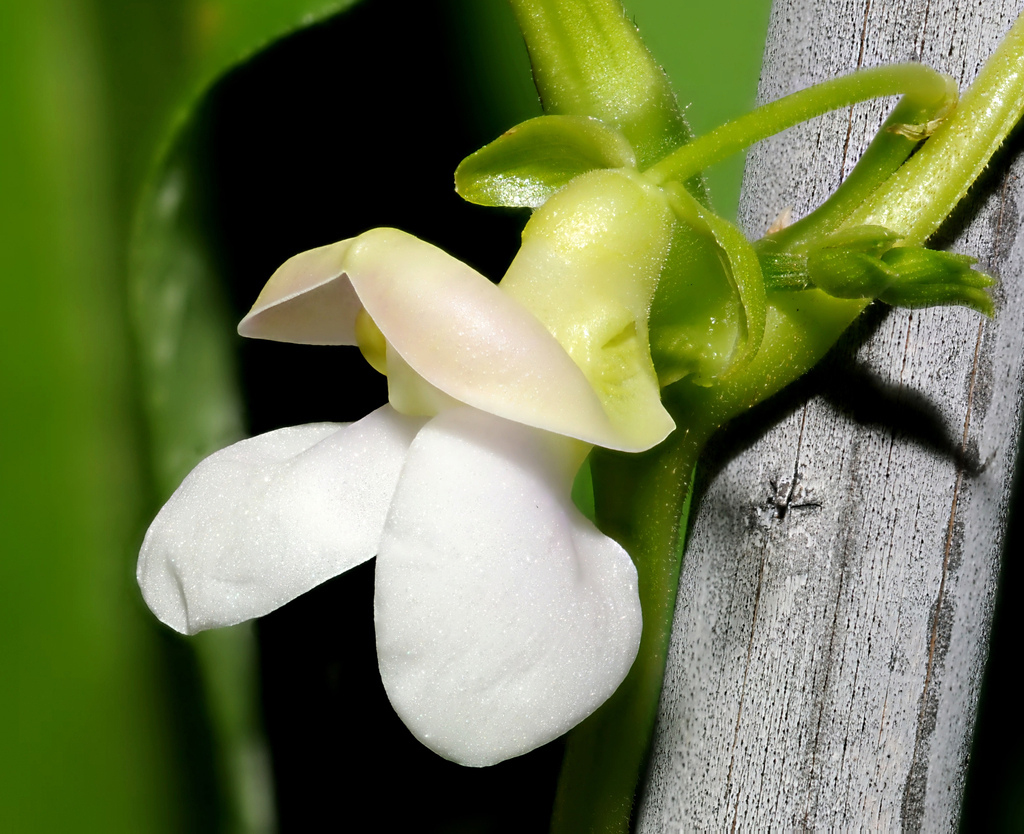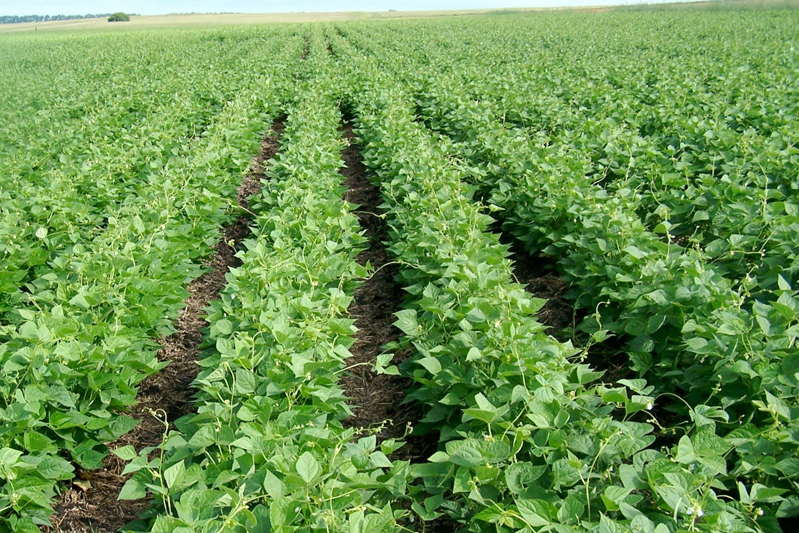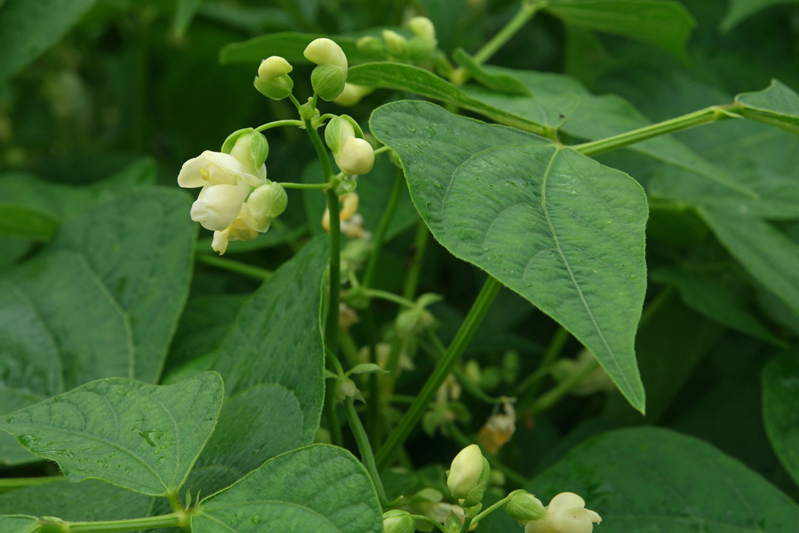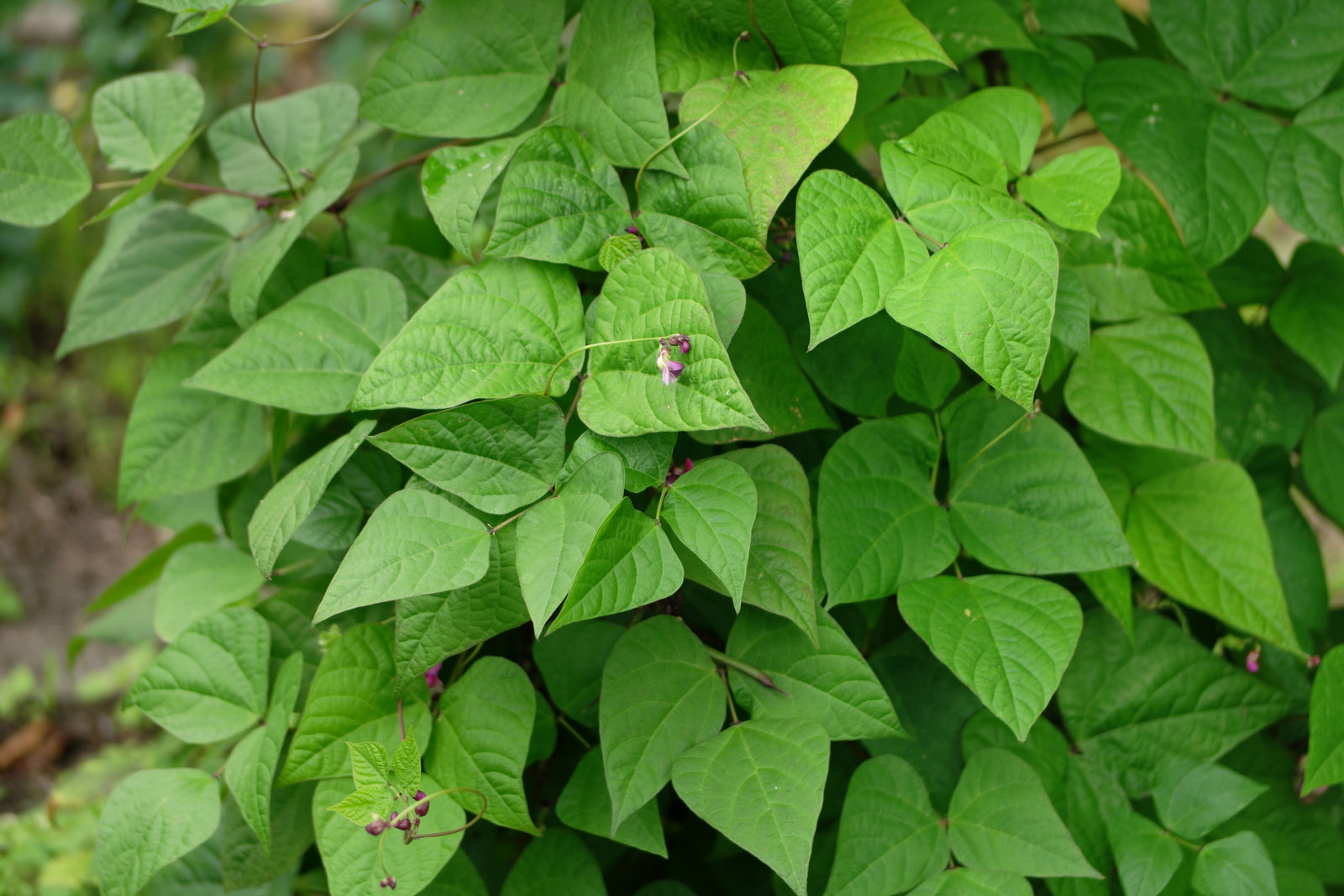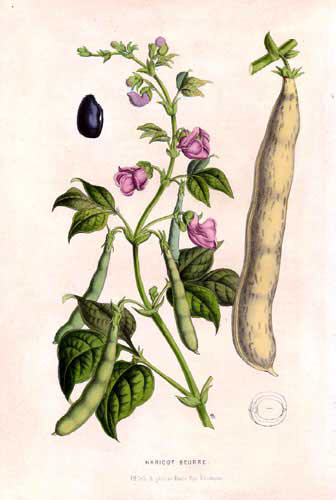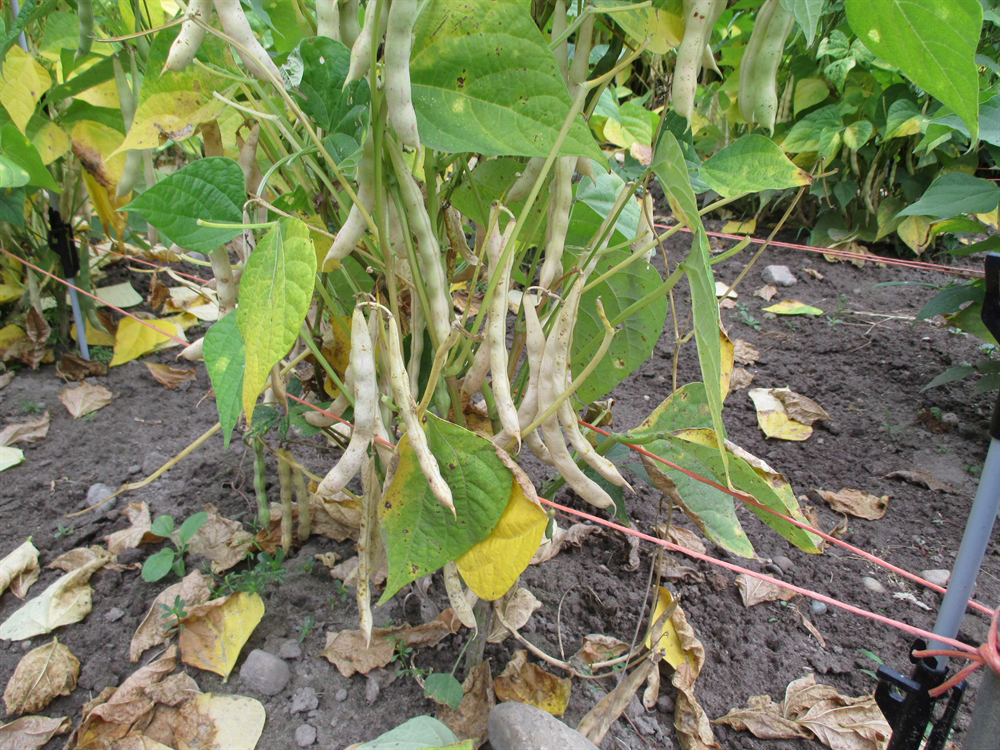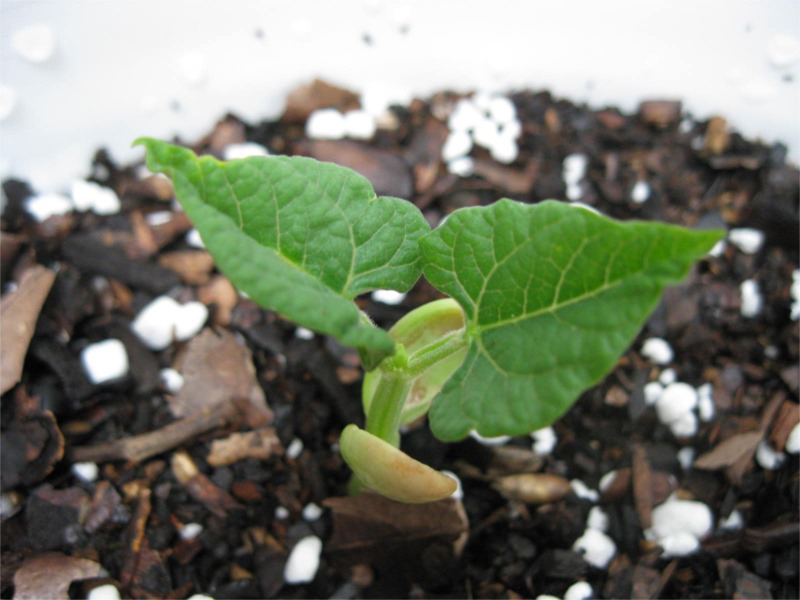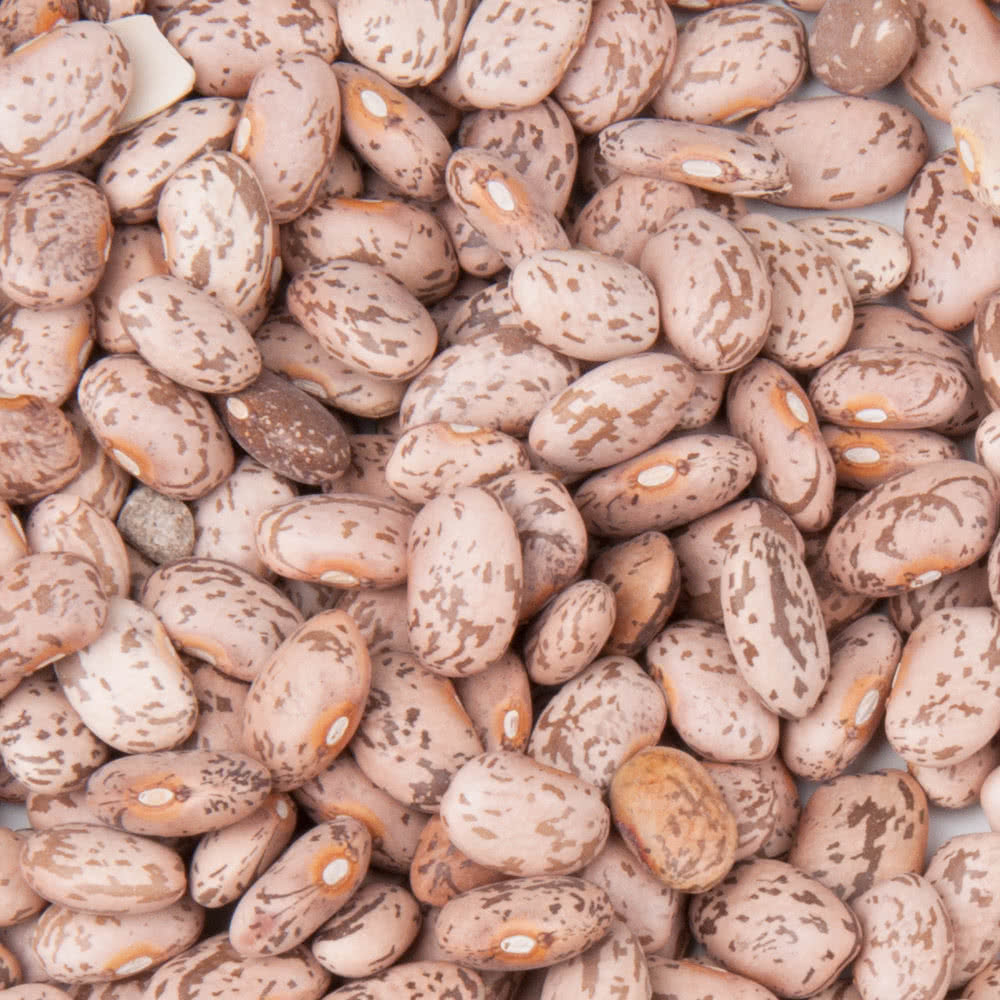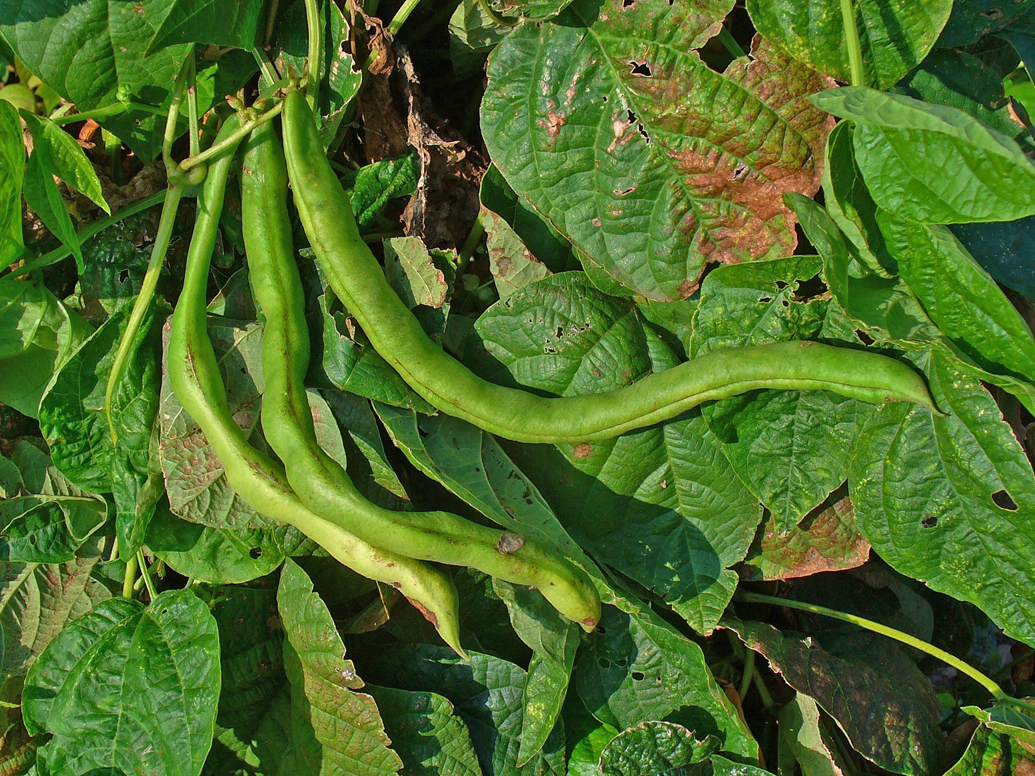Plant
Pinto bean is an annual, climbing or sub-erect herbaceous bush sized about 3 meters found growing in areas with long hot summers. It prefers medium-textured, well drained organic rich soils; avoid clay rich, heavy or soggy soil. It has 2-2.5 meters long pubescent stem that turns into glabrescent when grow old. Leaves are trifoliolate, alternate on 4–9 cm long petiole. Leaflets are 4–16 cm long, 2.5–11 cm broadly ovate to ovate-rhombic, acuminate, apex, rounded to broadly cuneate base, entire margin; lateral leaflets oblique; petiolule 1.5–2.5 mm long. Flowers are papilionaceous, bisexual. Calyx cup-shaped, Corolla white, pale pink, purple or yellow standard 9–12 mm long and glabrous, wings obovate, keel 10–12 mm long, spirally incurved. It is generally quite a low maintenance plant and is normally easy to grow and is great for beginner gardeners!
Beans
Pinto beans are 8–20 cm long by 1–2.5 cm wide, linear-oblong legume, slightly curved to broadly undulating, turgid, glabrous and beaked. They are green, black, yellow, purple, pink, white-pink mottled in color and have cream colored flesh with nutty flavor. One bean consists of 4–10 seeds that are white, red, brown, pink, black, mottled or variegated in 2 colors, plump, kidney-shaped oblong, or ensiform and 1–2 cm long and 0.5–1.3 cm wide seeds. Pinto beans are beans which are strewn along with spread reddish brown color and also have a beige background. Since they have spotted skin, they are also stated to as mottled beans. They seem just like paint works. This was the main reason why these beans are classified as pinto beans, as Pinto means ‘painted’ in Spanish. However this color splash appears unless you cook them. Whenever these beans are cooked, the color splash vanishes plus they turn pinkish brown colored, plus a creamy texture.
History
Phaseolus vulgaris is generally supposed to have originated in the Americas, along with two centers of domestication. Small seed varieties were proposed to have domesticated from small-seeded wild type in Central America whereas large-seeded varieties from large-seeded type in the Andean region of South America. Europe is considered as a secondary diversification center for P. vulgaris germplasm. Commercial production of beans is well-distributed worldwide with countries in Asia, Europe, Africa, Oceania, South and North America all among the top bean growers. India and Brazil are the top global producers of dry beans and the largest producer of green beans.
Nutritional Value
Apart from their mild delightful taste pinto bean is a good source of nutrients, vitamins and minerals. Consuming 171 gram of pinto beans offers 294 µg of Vitamin B9 (Folate, Folic acid), 3.57 mg of Iron, 0.374 mg of Copper,15.4 g of Total dietary Fiber, 251 mg of Phosphorus,44.84 g of Carbohydrate, 0.775 mg of Manganese, 15.41 g of Protein,0.392 mg of Vitamin B6 and 0.33 mg of Vitamin B1. Moreover many Amino acids like 0.185 g of Tryptophan, 0.566 g of Threonine, 0.728 g of Isoleucine, 1.308 g of Leucine and 1.077 g of Lysine are also found in 171 gram of the Pinto beans.
Health benefits of Pinto beans
Pinto beans is full of important vitamins, minerals, amino acids and other nutrients which are extremely important for our life. Frequent consumption of pinto beans are essential to fulfill the essential nutrients in the body and to live healthy and prosperous life.
How to Eat
- They are grown mainly for the dried pulse in Latin America and parts of tropical Africa.
- They are grown for the green immature pods which are consumed as a vegetable and are also canned and frozen in Europe, the United States and other temperate countries.
- Leaves are also used as vegetables in Southeast Asia and Papua New Guinea.
- Bean is used whole in broth or mashed and refried and is used as filling for burritos.
- Pinto beans are used in chili con carne, a spicy meat stew.
- Either whole or mashed, it is used common filling in burritos.
- Young pods may also be harvested and cooked as green pinto beans.
Other Traditional uses and benefits of Pinto beans
- Bean pods are the most widely used traditional cures against diabetes mellitus.
- Pinto Bean pod tea is extremely beneficial for sciatica, chronic rheumatism, dropsy, kidney and bladder problems, uric acid accumulations, and loss of albumin in the urine during pregnancy.
- It promotes healing of ulcers and sores.
- Acne can be cured by prolonged usage of the decoction prepared from the beans.
- Bean meal can also be applied directly to the skin for moist itching, eczema and eruptions and Wash the skin every 2-3 hours with German chamomile tea and apply new meal.
Pinto beans – Phaseolus vulgaris Facts
Pinto beans is an annual, herbaceous bush which can be found growing in medium-textured, well drained organic rich soils; avoid clay rich, heavy or soggy soil. It is full of essential nutrients and is important to remain healthy and happy.
| Pinto Beans Quick Facts | |
|---|---|
| Name: | Pinto Beans |
| Scientific Name: | Phaseolus vulgaris |
| Origin | America |
| Colors | White, brown, pink, red, black, mottled or variegated in 2 colors |
| Shapes | Plump, oblong, kidney-shaped or ensiform,1–2 × 0.5–1.3 cm |
| Flesh colors | Creamy white |
| Taste | Delicious |
| Calories | 245 Kcal./cup |
| Major nutrients | Vitamin B9 (73.50%) Iron (44.63%) Isoleucine (43.54%) Tryptophan (42.05%) Valine (42.00%) |
| Name | Pinto Beans |
|---|---|
| Scientific Name | Phaseolus vulgaris |
| Native | Originated in the Americas |
| Common/English Name | Borletti Bean, Common Haricot, Bush Bean, Haricots Tachetes, Climbing Bean, Common Bean, Kidney Bean, Runner Bean, Dry Bean , Snap Bean, Dwarf Bean, Green Bean, French Bean, Frash Bean, Field Bean, Pop Bean, Flageolet Bean, Pole Bean, Garden Bean, Pea Bean, Wax Beans, Haricot Bean, Kidney Bean, Mange-Tout, Navy Bean, Popping Bean, Dry Bean, String Bean |
| Name in Other Languages | Angola : Otchipoke ( Umubumbu ) Hawaian : Bakla Danish : Almindelig Břnne Burmese : Bo Sa Pè Greek : Fasiolos Koinos Argentina : Chicharo Ecuador : Fréjol Czech : Fazol Obecný Brazil : Feijão German : Bohne Chuvash : Shalsa Parsi Dutch : Boon Gabon : Modjangi Cuba : Frijol Belarusan : Fasolya Zvychainaya Honduras : Frijol French : Haricot Commun Indonesia : Boncis Guatemala : Frijol Paraguay : Habilla Nepali : Dolo Simi Democratic Republic of Congo : Cishimbo Eastonian : Harilik Aeduba Armenian : Lobi Sovorakan Finnish : Salkopapu Bolivia : Chicharo Japanese : Ingen Mame Chile : Chicharo Georgian : Lobio India : Bakla Russian : Fasol’ Obyknovennaia Chinese : Bai Fan Dou Italian : Fagiolo Azerbaijan : Adi Lobya Mali : Nii Portuguese : Feijão Dominican Republic : Habichuela El Salvador : Frijol Venezuela : Caraota Philippines : Sitao Korean : Gang Nang K’ong Moldavian : Fasole Urketoare Hungarian : Bab Columbia : Alubia Norwegian : Hagebønne Pakistan : Loba Fasoulia Latvian : Parastas Pupinas Uganda : Mattu Wanyambi ( Bugisu ) Slovencina : Fazuľa Obyčajná Quechuan : Purutu Costa Rica : Frijol Mong : Chichees Buurtzag Panama : Chicharo Uruguay : Chicharo Kampuchean : Sândaèk Barang Laos : Mak Thaoua Khek Malaysia : Kacang Buncis Spanish : Alubia Mexico : Ejote Nicaragua : Frijol Peru : Chicharo Ubzek : Loviya Taiwan : Pan Wen Tou Polish : Fasola Zwyczajna Thai : Thua Khaek Vietnamese : Ðậu Ve Slovašcina : Fižol Navadni Swahili : Mharagwe Swedish : Böna Ukranian : Kvasolya Zvichaina Swiss : Bruna Bonor Lithuanian : Darzines Pupeles Puerto Rico : Habicuela Turkish : Fasulye |
| Plant Growth Habit | Annual, climbing or sub-erect herbaceous bush |
| Growing Climate | Grow best in areas with long hot summers |
| Soil | Medium-textured, organic rich, well-drained soils |
| Plant Size | About 3 meters |
| Stem | 2–3 m long pubescent stem, glabrescent when old |
| Leaf | Leaf trifoliolate, alternate on 4–9 cm long petiole |
| Leaflets | 4–16 cm long, 2.5–11 cm broadly ovate to ovate-rhombic, acuminate, apex, rounded to broadly cuneate base, entire margin; lateral leaflets oblique; petiolule 1.5–2.5 mm long; |
| Flower | Papilionaceous, bisexual. Calyx cup-shaped, Corolla white, yellow, purple or pale pink, standard 9–12 mm long and glabrous, wings obovate, keel 10–12 mm long, spirally incurved. |
| Bean shape & size | 8–20 cm long by 1–2.5 cm wide, linear-oblong legume, slightly curved to broadly undulating, turgid, glabrous, beaked |
| Bean Color | Green, yellow, black, purple, pink, white-pink mottled in color, |
| Flesh Color | Cream Color |
| Flavor/aroma | nutty flavored |
| Seeds | 4–10, white, brown, pink, red, black, mottled or variegated
in 2 colors, plump, oblong, kidney-shaped or ensiform,1–2 × 0.5–1.3 cm |
| Varieties/Types | Burke, sierra, Hidatsa, Maverick and Othello |
| Major Nutrition | Vitamin B9 (Folate, Folic acid) 294 µg (73.50%) Iron, Fe 3.57 mg (44.63%) Isoleucine 0.728 g (43.54%) Tryptophan 0.185 g (42.05%) Valine 0.887 g (42.00%) Copper, Cu 0.374 mg (41.56%) Total dietary Fiber 15.4 g (40.53%) Phosphorus, P 251 mg (35.86%) Leucine 1.308 g (35.39%) Carbohydrate 44.84 g (34.49%) Histidine 0.422 g (34.25%) Manganese, Mn 0.775 mg (33.70%) Lysine 1.077 g (32.21%) Threonine 0.566 g (32.16%) Protein 15.41 g (30.82%) Vitamin B6 (Pyridoxine) 0.392 mg (30.15%) Vitamin B1 (Thiamin) 0.33 mg (27.50%) Magnesium, Mg 86 mg (20.48%) Selenium, Se 10.6 µg (19.27%) Potassium, K 746 mg (15.87%) Zinc, Zn 1.68 mg (15.27%) Vitamin E (alpha-tocopherol) 1.61 mg (10.73%) |
| Health Benefits | |
| Calories in 1cup (100gm) | 245 Kcal |
References:
https://en.wikipedia.org/wiki/Pinto_bean
http://www.agriculturalproductsindia.com/cereals-pulses/cereals-pinto-bean.html
https://myfolia.com/plants/1224-pinto-bean-phaseolus-vulgaris


